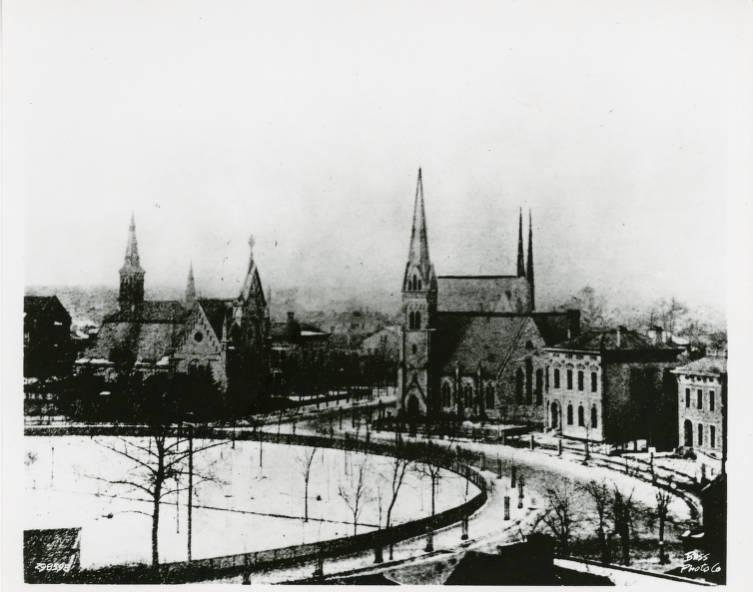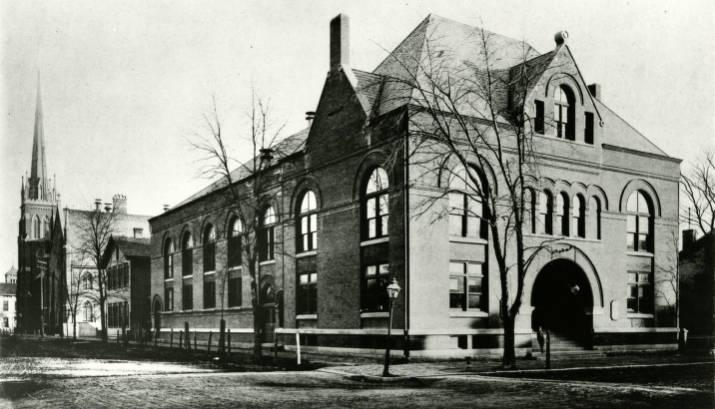Plymouth Church, organized in 1857 as the first Congregational church in Indianapolis, was one of the five original churches on . Plymouth’s 31 original members from the American Home Missionary Society met in a private home and the Senate chamber of the until their first church building on the northwest corner of the Circle was finished in 1859. Reverend Nathaniel Alden Hyde served as the first full-time pastor. The church added a 500-seat auditorium in 1867. By 1877, Congregationalists numbered about 2,000 across the state and maintained two churches in Indianapolis.

At that time, Plymouth Church had a small congregation and considerable debt when Reverend assumed leadership of the church. McCulloch was a proponent of the Social Gospel, a liberal theology that emphasized social action, especially how to apply Christianity to questions of economics, business ethics, labor organizing, and other problems in cities. He sought to become the minister to the entire city of Indianapolis, not just the minister of his denomination.
Like other Social Gospel ministers, McCulloch called for structural solutions, social justice, and equal employment opportunity, not merely palliative charity that only alleviated symptoms of social inequities. The “open door” became the church’s motto as McCulloch vowed the church doors would always be open. Plymouth’s membership gradually supported a plan to transform Plymouth Church into an “institutional” church that offered a variety of social services.

Plymouth sold its building on Monument Circle to around 1880, and he leased it until 1883. The church was then replaced by the , although a small chapel with stained glass windows was preserved. The congregation moved in 1884 into its new church building on the southeast corner of New York and Meridian Streets.
Plymouth’s new building included a 1,200-seat auditorium, classrooms, a gymnasium, a library, and office space which was leased to charitable organizations. The new church entrance blazoned the inscription, “The gates of it shall not be shut by day,” informing all passers-by that this was a place of “weekly renewal of sympathies and affections.” The new building also housed offices of several important charities, including the Indianapolis Benevolent Society and the for which McCulloch served as president.

McCulloch specially designed Sunday morning and evening services to reach two audiences, the wealthy and the poor. Morning services remained geared to the traditional audience with religious themes. Evening services catered to the working class, addressed social topics in addition to religious services, and even featured stereopticon pictures and music. Both services became immensely popular and church membership grew multifold, with an average attendance of 500 in the morning and 1,000 in the evening by the mid-1880s.
Plymouth Church formed charitable programs, a literary society, lecture series, library, travel club, youth programs, and a savings and loan service. The congregation organized the ladies’ church society to raise money, extend relief to needy congregants, call on members and non-members at home, and run social events. The minister’s wife, Alice McCulloch, led the ladies who visited “strangers.” The lecture series featured well-known guests, including former minister , African American leader Booker T. Washington, British authors Charles Dickens and Oscar Wilde, American authors Mark Twain, and .
When McCulloch died in 1891, Plymouth Church lacked the forceful leadership to continue many of his social programs. Literary clubs continued to sponsor lectures, including William Dean Howells in 1899 and reformer Jacob Riis in 1900, but the congregation declined. In 1903, the government purchased the property to build the . Five years later, Plymouth merged with Mayflower (Congregational) Church to form First Congregational Church, which met at 16th and Delaware streets. In 1957, First Congregational Church relocated to 7171 North Pennsylvania Street where it remains.

Help improve this entry
Contribute information, offer corrections, suggest images.
You can also recommend new entries related to this topic.